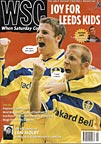 The claim that Wembley has more space may not have as much weight as first thought says Chris Lynham
The claim that Wembley has more space may not have as much weight as first thought says Chris Lynham
No matter who it is who eventually fulfils their destiny and reaches those famous Twin Towers just off the North Circular, it’s only a matter of time before the size of the formidable Wembley playing surface is offered as the key to the outcome.
Every novice manager of some upstart outfit who have stumbled into the play-off or FA Vase final will always rattle off a eulogy to Wembley’s wide open spaces in his first pre-match interview. Strategies are formulated to utilise nippy wingers in order to exploit the space down the flanks. Lumbering stalwart defenders are confined to the bench in fear of their inability to cover adequately the acres of turf at the back. And after the final whistle, with the dream in tatters, an excuse couldn’t be more readily available if it was highlighted in pink neon the length of Wembley Way.
Well, excuse me, but this, quite frankly, is a load of bollocks. There haven’t been wide open spaces at Wembley Stadium since those in the stands when England played friendlies during Graham Taylor’s reign. The latest to endorse the myth of the size of the Wembley pitch have been Arsenal, during the hyper-analysis of their latest Champions League flop. Both Davor Suker and Lee Dixon have cited the old chestnut as sufficient evidence to call for a return to Highbury for European fixtures. Dennis Bergkamp has voiced the opinion that their overseas adversaries have adapted far better to the challenge posed by our national stadium’s gargantuan field than poor old Arsenal.
Of course, the ageing rearguard would have shackled Batistuta and Rivaldo to the point of coma in the confines of their cramped Highbury headquarters. There are acres of desolate frozen wasteland in Sweden, so no wonder plucky AIK Solna gave our agoraphobic runners-up such a scare.
Do the facts really endorse what our heroes are claiming? Is the Highbury pitch, measuring 110 yards x 73 yards, a mere postage stamp in comparison to the 115 x 75 available to frolicking foreigners at Wembley? The superhuman effort necessary to cover that additional five yards’ width is beyond these finely tuned athletes, is it? They should have tried playing on some of the pitches I grew up on. Unbounded by such trivialities as touchlines, you would always get some dedicated duo who would go romping off over the hills chasing a plastic flyaway ball which all their team-mates had long since given up as lost. Way after the bell for the end of play-time had sounded our wheezing combatants would return, sweaty and grass-stained, wondering why they had made such an effort.
Aside from the blindingly obvious observation that conditions are the same for both sides (except in Arsenal’s case, where they enjoy the considerable advantage of playing at the stadium more regularly than their opponents), Wembley’s pitch is not significantly larger than any other in the league. Wake up and smell the horse shit, boys. It’s an optical illusion. The moon may look larger than the stars, but it’s not. The wheels on a Wild West wagon may appear to be going backwards, but they’re not. The only reason you should get more puffed out at Wembley is due to running after the ball every time it’s lumped out of play.
Myths are nothing new at the Venue of Legends of course. The Mecca of English football is where dreams are re-enacted. It’s where names are made. It’s where cliches breed. The glory of the Matthews Cup final. The thrill of the White Horse final. The beaming Bobby Moore and the prancing Nobby Stiles. The four-goal salvo against Holland. The Ricky Villa mazy dribble.
It’s all rubbish. Wembley is a carbuncle in north London where harrowing, hurtful events unfold, leaving its traumatised attendees to make the distraught trip back to the real world with their hopes and dreams cruelly snatched away from them. There’s nothing romantic about Wembley Stadium, big pitch or otherwise. Does anyone else feel as I do, or is it just Gillingham fans?
From WSC 156 February 2000. What was happening this month